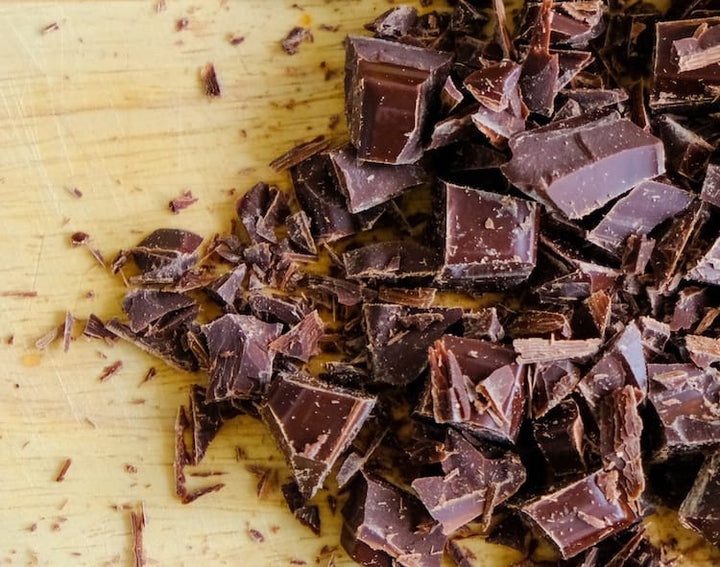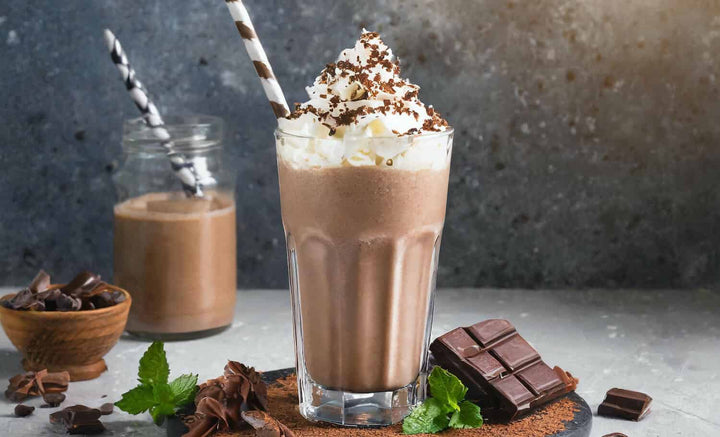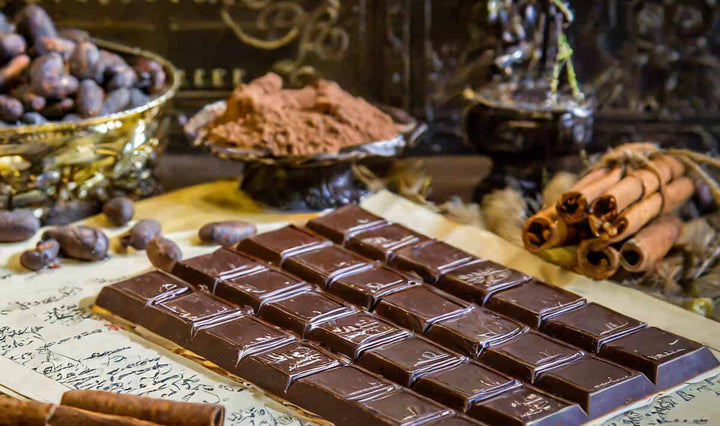Chocolate, the treat loved by many across the UK, has a rich history and an even richer variety of types and flavours.
But delve deeper into the makeup of your favourite bar, and you'll often find sugar playing an important role.
From the dark and intense to the sweet and milky, the sugar content in chocolate can vary immensely.
But why is sugar added, and how does it influence the taste and texture of chocolate?
How Much Sugar is in Chocolate?
Amount of Sugar in Chocolate (per 100 grams):
| Type of Chocolate | Sugar Content (grams) |
| Dark Chocolate | 5g - 30g |
| Milk Chocolate | 45g - 60g |
| White Chocolate | 50g - 65g |
Some more details:
-
Dark Chocolate: The sugar content in dark chocolate can vary widely based on its cocoa content. Generally, chocolates with higher cocoa percentages contain less sugar. A 70% cocoa chocolate bar, for instance, would be on the lower end of the sugar scale, whereas a 50% cocoa bar would have considerably more sugar.
-
Milk Chocolate: This type of chocolate typically contains a larger amount of sugar than dark chocolate. The milk solids in milk chocolate not only give it a creamier texture but also complement a sweeter flavour profile. Thus, manufacturers add more sugar to achieve that signature taste.
-
White Chocolate: Despite not containing any cocoa solids, white chocolate can often have the highest sugar content of all the chocolate varieties. The primary components of white chocolate are cocoa butter, milk solids, and sugar. Since it lacks the strong cocoa flavour found in dark and milk chocolate, the sugar plays a pivotal role in defining its sweet and creamy taste.
It's worth noting that these figures can vary based on the brand and specific recipe of the chocolate.
For a more accurate idea of sugar content, always check the nutritional information on the packaging.
How Much Sugar is in Dark Chocolate?
Dark chocolate is often favoured for its intense cocoa flavour and is typically less sweet than its milk or white chocolate counterparts.
The sugar content in dark chocolate can vary widely, largely depending on the percentage of cocoa it contains.
Typically, the sugar content in dark chocolate can be broken down as follows:
- 70-85% cocoa content: Between 15g and 25g of sugar per 100g.
- 50-69% cocoa content: Between 30g and 45g of sugar per 100g.
However, it's essential to understand that these are generalised figures.
The actual sugar content can vary based on the brand, country of production, and specific recipe formulations.
Dark chocolates with even higher cocoa percentages, such as 90% or 99%, will have even less sugar, sometimes as little as 5g per 100g or even less.
For those watching their sugar intake or simply curious about the exact amount of sugar in their favourite bar, it's always a good idea to consult the nutritional information on the chocolate's packaging.
This will provide a precise breakdown of its sugar content and other nutritional components.
How Much Sugar is in Milk Chocolate?
Milk chocolate is a delightful treat cherished by many across the UK for its creamy texture and a sweeter taste compared to dark chocolate.
This signature sweetness can be attributed to its sugar content, which is typically higher than that of dark chocolate.
On average, milk chocolate contains:
- Between 45g and 60g of sugar per 100g.
The exact sugar content, however, can vary based on several factors:
-
Brand Differences: Different chocolate manufacturers have unique recipes, leading to variances in sugar content. Some brands might have a slightly more sugary taste, while others might offer a milk chocolate with reduced sugar.
-
Variations in Cocoa Content: Even within the category of milk chocolate, the percentage of cocoa can differ, impacting the overall sugar content. A milk chocolate with higher cocoa content will generally have less sugar compared to one with lower cocoa content.
-
Additional Ingredients: The inclusion of ingredients like caramel, fruit, or nuts can influence the sugar content.
How Much Sugar is in White Chocolate?
White chocolate, distinguished by its pale hue and creamy, velvety texture, stands out in the chocolate world.
Unlike dark and milk chocolates, it doesn't contain cocoa solids, relying instead on cocoa butter, milk solids, and, of course, sugar for its unique flavour profile.
On average, white chocolate contains:
- Between 50g and 65g of sugar per 100g.
A few considerations account for the variations in sugar content:
-
Brand Specifics: As with all chocolates, different manufacturers have their signature recipes. Some brands may opt for a sweeter palate, adding more sugar, while others might tone it down a tad.
-
Additional Flavourings: Ingredients like vanilla or other flavour enhancers, as well as inclusions like berries or nuts, can influence the overall sugar content and taste.
-
Target Audience: Some white chocolates, especially those tailored for children, might have a sweeter profile and therefore, a slightly higher sugar content.
Considering its components, it's not surprising that white chocolate tends to be on the sweeter side.
How Much Sugar is Safe to Eat Each Day?
Maintaining a balanced diet is fundamental to our health and well-being.
Sugar, while often a pleasurable part of our meals, is a component that needs careful monitoring to ensure we're not consuming it in excess.
According to the NHS and other health organisations:
-
Adults: It's recommended that sugar intake for adults should not exceed 30g a day, which equates to approximately 7 sugar cubes.
-
Children aged 7 to 10: Their daily intake should be no more than 24g of sugar, roughly equivalent to 6 sugar cubes.
-
Children aged 4 to 6: They should consume no more than 19g, which translates to about 5 sugar cubes.
For children under 4, it's advised to avoid sugar-sweetened drinks and foods with added sugars.
A few important points to note:
-
Natural vs Added Sugars: Not all sugars are created equal. The guidelines above refer predominantly to 'free' or added sugars, which are sugars added to foods and drinks, as well as sugars found naturally in honey, syrups, and unsweetened fruit juices. Sugars in whole fruits, vegetables, and dairy don't fall into this category and aren't included in the aforementioned daily limits.
-
Hidden Sugars: It's worth being vigilant about 'hidden' sugars in items that may not seem sweet at first glance, such as in sauces, ready meals, and certain cereals.
-
Health Implications: Excessive sugar consumption is linked to various health issues, including obesity, tooth decay, and increased risk of type 2 diabetes.
As with all dietary considerations, individual needs can vary based on factors like age, metabolism, physical activity levels, and overall health.
Where Can You Buy Scrumptious Chocolate?
If you're on the hunt for truly scrumptious chocolate, look no further than Whitakers Chocolates.
We've been masters of chocolate making for over 130 years, using our rich heritage and unrivalled expertise to craft truly mouth-watering treats.
At Whitakers, our passion for chocolate is matched only by our commitment to quality.
We firmly believe in using only 100% natural ingredients in our chocolates.
We source high-quality cocoa, pure and rich, and turn it into an array of delightful creations.
You won't find any artificial additives in our products - nothing nasty ever makes its way into a Whitakers chocolate.
We also understand that, in this day and age, it's not enough just to make delicious chocolate.
That's why we're proud to say that all our packaging is fully recyclable and made from recyclable materials.
When you savour a piece of Whitakers chocolate, you can do so knowing that not only does it taste great, but the packaging it came in is responsible and environmentally-friendly.
Our range of chocolates is vast, designed to satisfy every palate and meet a variety of dietary needs.
Whether you're a vegetarian, vegan, or adhering to a gluten-free lifestyle, you're certain to find something in our collection to suit your needs.
From the classic milk and dark chocolates to innovative flavours and beautifully packaged gifts, every product is a testament to our long-standing tradition of excellence in chocolate making.
So, why not explore our selection and experience the delight of Whitakers Chocolates for yourself?
A world of rich, indulgent, responsibly-made chocolate awaits you.
Trust us, with over a century of chocolate-making expertise under our belt, we know a thing or two about creating truly scrumptious treats.
Here are some of our favourite treats:
- Gold foiled milk chocolate hearts
- Dark chocolate fondant creams infused with natural Raspberry oil
- Luxury assorted chocolate truffle gift box
- Assorted Summer Fruit fondant creams
- Milk chocolate and cappuccino flavoured Neapolitans gift box
Some Notes From an Expert Chocolatier
Having devoted decades to the art of chocolate-making, the topic of sugar in our beloved treat is one I've often been asked about.
The journey from bean to bar is intricate, and the role of sugar within that process is paramount.
Here are my thoughts on the subject, grounded in years of experience and passion:
-
Purpose of Sugar: Sugar does more than just sweeten the chocolate; it balances the natural bitterness of the cocoa bean. The intensity of the cocoa flavour and the origin of the bean can determine the required sugar content. It's a delicate balance to strike, ensuring the sugar neither overpowers nor is overpowered by the cocoa.
-
Varieties of Chocolate: Dark, milk, and white chocolates have distinct sugar profiles. Dark chocolate traditionally contains less sugar than milk or white varieties, reflecting its deeper, more intense cocoa character. Milk chocolate, with its added milk solids, offers a creamier, sweeter experience. Meanwhile, white chocolate, devoid of cocoa solids, leans on sugar and cocoa butter for its signature taste.
-
Artisan vs Commercial: Artisan chocolates often have a more nuanced sugar content, tailored to complement unique flavour combinations and high-quality beans. On the other hand, some commercial chocolates, particularly those targeted at younger audiences, might contain higher sugar levels to cater to a sweeter palate.
-
Balance is Key: While chocolate is a delightful indulgence, moderation is crucial. A balanced diet, rich in whole foods and low in processed sugars, allows for occasional treats without compromising health. Remember, a little quality chocolate can satisfy a craving more effectively than larger quantities of sugar-heavy alternatives.
-
Being Informed: As a chocolatier, I believe in transparency. Always check the label for sugar content and aim for chocolates with fewer additives and more natural ingredients.
-
A Holistic Approach: Beyond sugar, consider the overall experience of eating chocolate. Savour it slowly, allowing the flavours to unfold on your palate. This mindful approach not only enhances enjoyment but often means we're satisfied with less.
Final Notes On the Amount of Sugar in Chocolate
Navigating the world of chocolate can be a delightful, yet intricate journey, with sugar content playing a crucial role in the overall experience.
The variances in sugar levels across dark, milk, and white chocolates reflect not just taste preferences but also the intricate balance required to counteract the natural bitterness of cocoa.
In the grander scheme, while chocolate remains one of life's simple pleasures, a conscious approach to its consumption ensures that it remains just that - a pleasure, savoured in moderation.
Remember, balance in all things is key, and understanding the sugar content in our favourite treats is an integral part of a holistic, healthy lifestyle.











